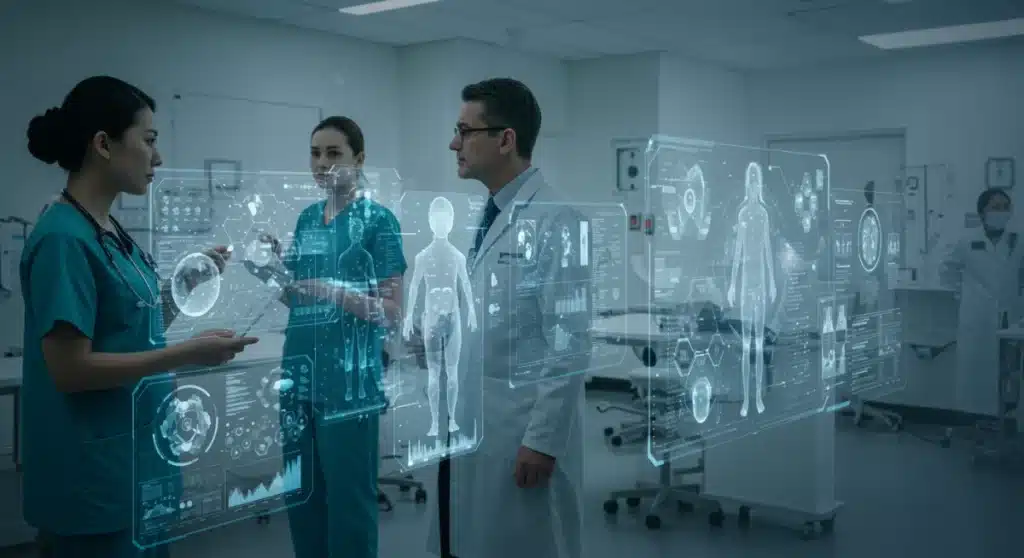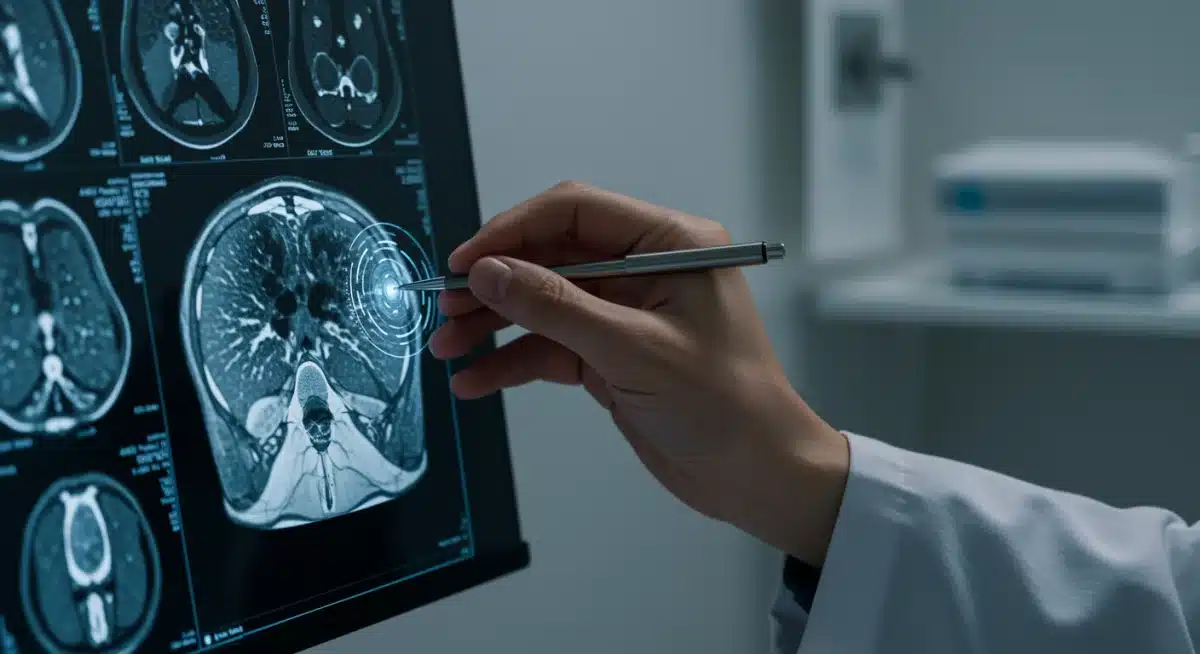AI in Healthcare Diagnostics: 18% Accuracy Boost by Mid-2025

AI in healthcare diagnostics is poised to improve accuracy by 18% in US hospitals by mid-2025, signaling a pivotal shift in medical precision and patient treatment strategies.
The integration of artificial intelligence is rapidly reshaping the medical landscape, with The Role of AI in Healthcare Diagnostics: Improving Accuracy by 18% in US Hospitals by Mid-2025 emerging as a critical development. This groundbreaking advancement promises a future where diagnostic precision is significantly elevated, ultimately leading to better patient outcomes and more efficient healthcare delivery.
AI’s Transformative Impact on Diagnostic Precision
Artificial intelligence is fundamentally changing how medical diagnoses are made, moving beyond traditional methods to offer unparalleled levels of accuracy. This shift is particularly evident in the United States, where hospitals are increasingly adopting AI-powered tools to analyze complex medical data.
The primary driver behind this transformation is AI’s ability to process vast amounts of information—from medical images to patient history records—at speeds and with insights far beyond human capabilities. This leads to earlier and more precise detection of diseases, which is crucial for effective treatment.
Enhanced Image Analysis Capabilities
One of the most significant applications of AI in diagnostics is its role in medical imaging. AI algorithms can detect subtle anomalies in X-rays, MRIs, and CT scans that might be missed by the human eye, even by experienced radiologists. This capability is proving vital in areas like oncology and cardiology.
- Early Cancer Detection: AI models can identify cancerous lesions at earlier stages, improving prognosis.
- Cardiovascular Disease Mapping: Precise analysis of heart scans helps in identifying risk factors and abnormalities.
- Neurological Disorder Identification: AI assists in pinpointing subtle changes in brain scans related to conditions like Alzheimer’s.
Current Adoption Rates and Projected Growth
As of early 2024, a growing number of US hospitals are piloting and implementing AI diagnostic systems. This adoption is not uniform, with larger academic medical centers often leading the charge, but the trend is clear and accelerating. The projected 18% improvement in diagnostic accuracy by mid-2025 highlights the rapid integration and measurable benefits expected from these technologies.
This growth is fueled by increasing investments in healthcare AI, alongside a growing body of evidence demonstrating its effectiveness. Hospitals are seeing tangible benefits in terms of reduced diagnostic errors and improved workflow efficiency.
Challenges in AI Integration
While the benefits are clear, integrating AI into existing healthcare infrastructures presents its own set of challenges. These include the need for robust data privacy measures, the development of standardized regulatory frameworks, and ensuring clinical staff are adequately trained to work alongside AI systems.
- Data Security: Protecting sensitive patient data is paramount when using AI algorithms.
- Regulatory Hurdles: Establishing clear guidelines for AI medical devices and software.
- Workforce Training: Educating healthcare professionals on how to effectively utilize AI tools.
Key Technologies Driving AI Diagnostic Advancements
Several cutting-edge AI technologies are at the forefront of this diagnostic revolution. Machine learning, particularly deep learning, forms the backbone of most AI diagnostic systems, enabling them to learn from vast datasets and improve their performance over time. Natural Language Processing (NLP) is also playing a crucial role in analyzing unstructured clinical notes and patient records.
The continuous evolution of these technologies, combined with increasing computational power, is paving the way for even more sophisticated and accurate diagnostic tools. These advancements are making AI an indispensable part of modern medical practice.

The development of specialized AI models for specific medical conditions is also contributing significantly. These models, trained on highly curated datasets, can provide very precise diagnostic assistance for particular diseases, showcasing the specialized power of AI in healthcare diagnostics.
Improving Patient Outcomes Through Enhanced Accuracy
The ultimate goal of integrating AI into healthcare diagnostics is to improve patient outcomes. An 18% increase in diagnostic accuracy translates directly into more timely and appropriate treatments, reduced instances of misdiagnosis, and ultimately, better health for patients. This is particularly impactful for conditions where early detection is critical.
Patients stand to benefit from faster diagnoses, reduced anxiety associated with waiting for results, and personalized treatment plans based on highly accurate insights. This human-centric approach underscores the value of technological advancement in medicine.
The Role of Predictive Analytics
Beyond current diagnostics, AI’s predictive analytics capabilities are helping identify patients at risk of developing certain conditions before symptoms even appear. This proactive approach allows for preventative interventions, further enhancing patient well-being and reducing the burden on healthcare systems.
- Risk Stratification: Identifying high-risk patient populations for targeted interventions.
- Disease Progression Forecasting: Predicting how diseases might evolve in individual patients.
- Personalized Medicine: Tailoring treatments based on individual genetic and lifestyle data.
Economic and Operational Efficiencies in Hospitals
Beyond clinical benefits, the adoption of AI in healthcare diagnostics offers significant economic and operational advantages for US hospitals. By reducing diagnostic errors and streamlining workflows, AI can lead to considerable cost savings and improved resource allocation. This efficiency is vital in an increasingly strained healthcare system.
AI can automate routine tasks, freeing up highly skilled medical professionals to focus on more complex cases and direct patient care. This optimization of human resources is a key benefit, allowing hospitals to operate more effectively and serve more patients.
Cost Reduction and Resource Optimization
The reduction in misdiagnoses means fewer unnecessary tests, treatments, and hospital readmissions, directly impacting healthcare costs. Furthermore, AI’s ability to optimize scheduling and resource utilization can lead to more efficient hospital operations overall.
The Future Landscape: Mid-2025 and Beyond
Looking towards mid-2025, the trajectory for AI in healthcare diagnostics is one of rapid expansion and deepening integration. The projected 18% accuracy improvement is just an initial milestone, with continuous advancements expected as AI models become more sophisticated and data-rich.
The coming years will likely see AI moving beyond diagnostic support to more autonomous roles, always under human supervision, and expanding into new specialties. This evolving landscape will necessitate ongoing collaboration between AI developers, clinicians, and policymakers to ensure responsible and effective deployment.
Ethical Considerations and Trust
As AI’s role expands, ethical considerations, including algorithmic bias, transparency, and accountability, will remain central. Building trust among patients and medical professionals is paramount for the successful long-term integration of AI into healthcare.
- Algorithmic Fairness: Ensuring AI systems are unbiased and equitable across diverse patient populations.
- Transparency: Making AI decision-making processes understandable to clinicians.
- Accountability: Establishing clear lines of responsibility for AI-driven diagnoses.
| Key Aspect | Brief Description |
|---|---|
| Accuracy Improvement | AI is projected to boost diagnostic accuracy by 18% in US hospitals by mid-2025. |
| Key Technologies | Machine learning, deep learning, and NLP are driving advanced diagnostic capabilities. |
| Patient Outcomes | Enhanced accuracy leads to earlier detection, better treatment, and improved patient health. |
| Operational Efficiency | AI reduces diagnostic errors and streamlines hospital workflows, optimizing resources. |
Frequently Asked Questions About AI in Healthcare Diagnostics
AI systems analyze vast amounts of medical data, including images and patient records, to identify subtle patterns indicative of diseases. This capability enhances precision, reduces human error, and facilitates earlier detection, leading to the projected 18% improvement in accuracy.
AI is particularly impactful in image-based diagnostics like radiology and pathology, aiding in the detection of cancers, cardiovascular diseases, and neurological disorders. It also assists in analyzing complex lab results and patient histories for more comprehensive diagnoses.
Potential risks include data privacy concerns, the need for robust regulatory oversight, and ensuring algorithmic fairness to prevent biases. It’s crucial to integrate AI responsibly, with continuous human supervision and ethical guidelines in place.
AI is designed to augment, not replace, healthcare professionals. It will free up clinicians from routine tasks, allowing them to focus on complex cases, patient interaction, and personalized care. Training and adaptation will be key for successful collaboration.
Widespread adoption is a continuous process, but significant improvements, such as the 18% accuracy boost, are anticipated by mid-2025. Full integration across all diagnostic areas will likely unfold over the next decade as technology matures and regulatory frameworks evolve.
What Happens Next
The projected 18% improvement in diagnostic accuracy due to AI in US hospitals by mid-2025 is more than a statistic; it signals a fundamental shift in healthcare delivery. This development will accelerate the demand for AI-literate medical professionals and necessitate further investment in secure, ethical AI infrastructure. Stakeholders across the healthcare ecosystem, from policymakers to technology developers, must continue to collaborate to ensure these advancements translate into equitable and accessible benefits for all patients. Expect ongoing discussions around regulatory frameworks and data governance to keep pace with rapid technological evolution.





